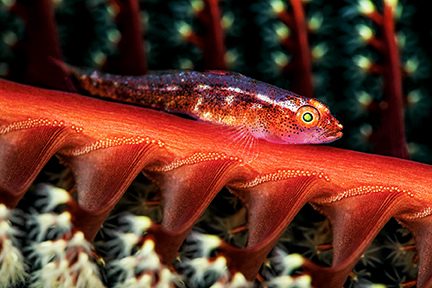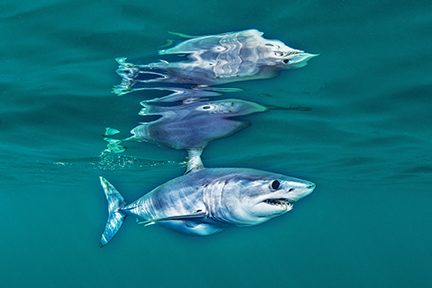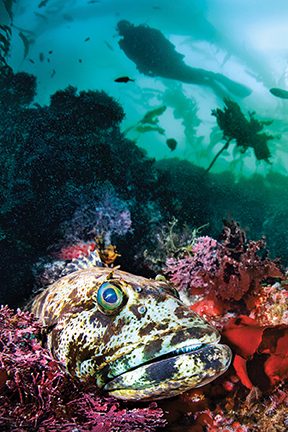LES PHOTOGRAPHES SOUS-MARINS PASSENT ÉNORMÉMENT DE TEMPS, energy, and money pursuing subjects. We often select our dive destinations with specific subjects in mind. Sharks or manta rays may send us in one direction, lush reefscapes direct us in another, and macro critters or blackwater subjects will point us in yet another. This strategy for capturing stunning photographs makes sense — a phenomenal central subject is often a large part of what makes a shot. But it takes more than a great foreground to create a truly standout image. The potential impact of even the most spectacular subject can rapidly diminish when positioned against an unattractive, cluttered, or awkward backdrop.
We connected on Instagram, and I became more familiar with his vision’s excellence and eclectic nature with each We don’t talk much about backgrounds in underwater photography, but we should. The unsung hero, the strongest supporter of a fabulous image’s subject, is a flawless background. A great background will frame and emphasize your subject, can provide a sense of environment, might introduce secondary subjects, and may sometimes even tell a story. A great background elevates an image and takes it from, “Wow, neat frogfish,” to, “Holy cow, what an incredible frogfish shot!”
RETOUR À L'ESSENTIEL
Photographic composition isn’t the topic of this article, but it’s impossible to effectively discuss backgrounds without touching upon a few applicable composition basics. One of the biggest pitfalls for photographers occurs when the excitement of discovering a great subject overtakes proper attention to how the subject is emphasized and positioned within the frame.
Pour nos besoins, contraste est un élément important. L'observateur doit pouvoir identifier facilement le sujet. Outre un bon éclairage et une bonne mise au point sur le sujet, le contraste est l'un des meilleurs moyens d'y parvenir. Un moyen courant d'obtenir un contraste sous l'eau est de se placer plus bas que le sujet et de tirer vers le haut ; cela permet souvent de distinguer le sujet de son habitat.
Le placement des sujets est également essentiel. L'utilisation de règles classiques telles que le règle des tiers (positioning an image’s focal point at an imagined intersection of equally spaced pairs of vertical and horizontal lines — think of a grid resembling a tic-tac-toe board) and the règle de l'espace (providing inferred “swim space” by leaving ample room ahead of the subject’s movement direction) can naturally guide photographers toward improved backgrounds. In addition, the use of lignes directrices ou par courriel à Courbes en S, which can help guide a viewer’s eye around an image, can be compelling components of an engaging backdrop.



CI-DESSUS À GAUCHE : Cette image d'un gobie commun est rehaussée par son emplacement parmi les branches parfaitement arrangées de son enclos de mer vibrant.
EN HAUT À DROITE : The contrast of the blue water emphasizes this mako shark, and the proximity of the glass-calm surface allowed the photographer to also capture the mako’s reflection.
GAUCHE : The placement of the primary subject in this image, a lingcod, illustrates the rule of thirds, with the fish’s eye situated at the lower left of the frame. The inclusion of the animal’s habitat — a lush kelp forest — and addition of a diver’s silhouette as a secondary subject creates for the viewer a sense of both environment and scale.
UNE APPROCHE POSITIVE
À L'ESPACE NÉGATIF
Negative space, defined as the empty space behind or around a subject, can be a powerful compositional tool. The use of a stark, simple background automatically attracts attention to the subject because there’s nothing else in the image to compete with it. The most popular illustration of this in underwater photography is a subject surrounded by a black background (the black part being the negative space). Photographers often achieve this effect by using external light sources and a high shutter speed to photograph a subject surrounded by open water on most or all sides.
The black background is usually applied to small subjects, although you can also use it beautifully with larger ones in dark conditions. The technique itself is simple to apply if you can identify and focus on a properly positioned subject — think of a critter on top of a rock or a passing creature during a blackwater dive. Because it delivers elegant, crisp images that are universally appealing, it’s sometimes worth spending some time during your dive looking for well-situated subjects.
Even when open water doesn’t surround a subject, it may still be possible to feature it against a black background by using a snoot. This tube fits over the end of an external light source and gives the shooter better control over the light’s radius and direction. These contraptions vary in complexity and cost, ranging from a simple pipe coupling from the local hardware store to more sophisticated systems using light-focusing lenses or fiber-optic technology. It can be challenging to execute a great snooted image, but it’s certainly worthwhile for a great subject with an otherwise so-so background. Although snoots are typically a macro tool, they can also selectively light items in a wide-angle scene and help highlight your subject within a busy or unappealing location.
Photographers don’t need to restrict themselves to a black background to showcase a striking use of negative space. If there’s adequate light in the water column, photographers create a blue or green water background by slowing the shutter speed, widening the lens aperture, and shooting at an upward angle. Bokeh, a shallow depth-of-field effect created by using a wide aperture to blur the background, is a great way to introduce unique negative space to a macro portrait of a great subject in an imperfect environment. The bokeh approach can even allow for unique backgrounds. Angling your lens toward a subject above a white sand seafloor may allow you to get a light-colored background, whereas angling your lens toward a nearby colored sponge or a branch of brightly colored soft coral might provide a hued background.
Vous pouvez parfois améliorer même l'arrière-plan le plus chargé en introduisant un flou de mouvement intentionnel, une technique avancée qui utilise une vitesse d'obturation lente tout en faisant pivoter l'appareil photo.

GAUCHE : Soft coral is a favorite subject of many shooters. In this image, the upright position of a colorful, shallow branch of soft coral leads the viewer’s eye toward the background, which includes sunrays filtering through the overhanging foliage. By aiming the camera at an upward angle, the photographer has also incorporated the edge of Snell’s window, faintly visible on the upper right side of the image.
L'EMPLACEMENT, L'EMPLACEMENT, L'EMPLACEMENT
Another striking way to showcase your subject is by capturing it in an attractive setting. There’s often an element of luck to this type of image, especially in wide-angle scenarios, so knowing the environment and preparing to photograph your subject in a way that captures the beauty of the area is critical. Using your camera’s light meter can aid this process, but nothing beats taking a few test shots as soon as you enter the water (as well as each time your depth or the ambient light changes notably) to ensure that you can capture the shot you’re envisioning.
Lorsque le paysage est particulièrement beau, même le sujet le plus banal mérite d'être photographié. Une méthode peu conventionnelle mais productive pour les petits sujets consiste à chercher d'abord une toile de fond attrayante, puis à inspecter la zone à la recherche d'une créature commensale. L'identification d'une anémone colorée ou d'une branche parfaite de corail mou, par exemple, et la recherche de poissons ou d'invertébrés occupant l'espace peuvent donner lieu à des clichés spectaculaires.
Vous pouvez appliquer une approche similaire aux images grand angle. Un banc de poissons qui passe, une caverne qui s'ouvre sous des rayons de soleil pénétrants ou un mur recouvert de coraux colorés en forme de coupe devraient inciter les amateurs d'arrière-plan à chercher un sujet de premier plan.
Si votre sujet se trouve dans des eaux très peu profondes, il existe des possibilités uniques d'obtenir un arrière-plan de grande qualité. Par temps calme, il est possible de capturer un reflet de votre sujet à la surface de l'eau. Pour les sujets plus grands ou lorsque vous utilisez un objectif grand angle, l'inclinaison vers le haut peut vous permettre de capturer des éléments de surface uniques, tels que des nuages, des feuillages en surplomb ou des personnes.
If conditions are ideal and you’re able to shoot toward the sky, it may be possible to incorporate Snell’s window into your background. This optical phenomenon results from refraction at the air/water boundary that manifests as a circular image of the entire above-water hemisphere. It provides a distinctive appearance that is well worth the effort to capture.
RÔLES SECONDAIRES
Including a secondary subject is a great way to add impact to an image. This common approach assimilates objects such as a sunburst, other marine life (including multiples of your main subject), or a diver into the background. A diver gazing at an adjacent subject or silhouetted high in the frame are common illustrations of this technique. Adding a diver as a secondary subject enhances the composition, creates relatability, and affirms that your primary subject is exciting — after all, the diver in your image is also viewing it.
Les sujets secondaires peuvent également fournir un contexte ; des situations telles que la prédation implicite (comme un poisson-lion avec un banc de poissons-appâts en arrière-plan) ou la reproduction (comme une demoiselle gardant un nid) sont des scènes qu'il est très souhaitable de capturer.
Adding a secondary subject can be tricky. It’s critical to guide the viewer’s gaze from the primary subject to the secondary subject and back again. Differences in focus or size are often good ways to lead the viewer and differentiate your subjects. The main subject should command an initial response from the viewer through sharp focus or larger size in the frame relative to a more softly focused or smaller secondary subject.
Photographers often spend their dives searching for spectacular subjects, and that’s as it should be. But remembering to take the time and effort to optimize the backdrop is a significant step to displaying a subject at its best. A photograph’s background may seem ancillary, but it’s a critical component of an image that can instantly improve or diminish the overall effect.
© Alert Diver - Q2 2022